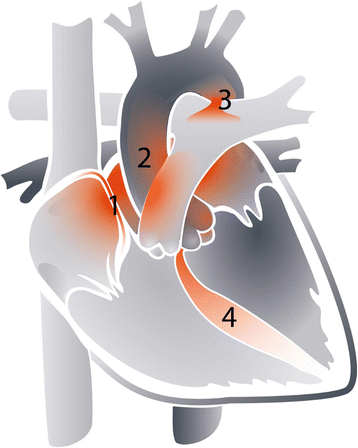Cardiac pathology in spinal muscular atrophy: a systematic review
- PMID: 28399889
- PMCID: PMC5387385
- DOI: 10.1186/s13023-017-0613-5
Cardiac pathology in spinal muscular atrophy: a systematic review
Abstract
Background: Hereditary proximal spinal muscular atrophy (SMA) is a severe neuromuscular disease of childhood caused by homozygous loss of function of the survival motor neuron (SMN) 1 gene. The presence of a second, nearly identical SMN gene (SMN2) in the human genome ensures production of residual levels of the ubiquitously expressed SMN protein. Alpha-motor neurons in the ventral horns of the spinal cord are most vulnerable to reduced SMN concentrations but the development or function of other tissues may also be affected, and cardiovascular abnormalities have frequently been reported both in patients and SMA mouse models.
Methods: We systematically reviewed reported cardiac pathology in relation to SMN deficiency. To investigate the relevance of the possible association in more detail, we used clinical classification systems to characterize structural cardiac defects and arrhythmias.
Conclusions: Seventy-two studies with a total of 264 SMA patients with reported cardiac pathology were identified, along with 14 publications on SMA mouse models with abnormalities of the heart. Structural cardiac pathology, mainly septal defects and abnormalities of the cardiac outflow tract, was reported predominantly in the most severely affected patients (i.e. SMA type 1). Cardiac rhythm disorders were most frequently reported in patients with milder SMA types (e.g. SMA type 3). All included studies lacked control groups and a standardized approach for cardiac evaluation. The convergence to specific abnormalities of cardiac structure and function may indicate vulnerability of specific cell types or developmental processes relevant for cardiogenesis. Future studies would benefit from a controlled and standardized approach for cardiac evaluation in patients with SMA.
Keywords: Cardiac abnormalities; Cardiac pathology; Kugelberg-Welander; SMA; Spinal muscular atrophy; Werdnig-Hoffmann.
Figures


References
Publication types
MeSH terms
Substances
LinkOut - more resources
Full Text Sources
Other Literature Sources
Medical
Molecular Biology Databases

